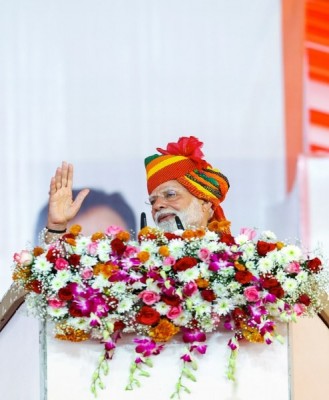
Indians are overjoyed as Chandrayaan 2 is a fully indegenous mission: Narendra Modi
New Delhi, July 22 (IBNS): Indian PM Narendra Modi on Monday said the country will be proud of the Chandrayaan 2 mission as it is a fully indegeneous project.
"Indian at heart, Indian in spirit! What would make every Indian overjoyed is the fact that #Chandrayaan2 is a fully indigenous mission. It will have an Orbiter for remote sensing the Moon and also a Lander-Rover module for analysis of lunar surface," Modi tweeted.
Indian at heart, Indian in spirit!
— Narendra Modi (@narendramodi) July 22, 2019
What would make every Indian overjoyed is the fact that #Chandrayaan2 is a fully indigenous mission.
It will have an Orbiter for remote sensing the Moon and also a Lander-Rover module for analysis of lunar surface.
Efforts such as #Chandrayaan2 will further encourage our bright youngsters towards science, top quality research and innovation.
— Narendra Modi (@narendramodi) July 22, 2019
Thanks to Chandrayaan, India’s Lunar Programme will get a substantial boost. Our existing knowledge of the Moon will be significantly enhanced.#Chandrayaan2 is unique because it will explore and perform studies on the south pole region of lunar terrain which is not explored and sampled by any past mission.
— Narendra Modi (@narendramodi) July 22, 2019
This mission will offer new knowledge about the Moon.
In a big moment for the country, the launch of Chandrayaan 2, which will travel to the moon, took place on Monday at exactly 2-43 pm. The lift-off was perfect, said ISRO scientists as they sat in the control room watching the lift-off and it hurtled towards the outer atmosphere, propelled by the 640-tonne rocket, named Baahubali.
Chandrayaan-2 is carrying an Orbiter, Lander (Vikram) and Rover (Pragyan). They took to skies from the SHAR Range at Sriharikota, commencing its 3.844 lakh km, month-long journey for a soft landing on the Moon's South Pole.
ISRO chief K Sivan announced soon that the rocket has "successfully injected Chandraayan 2 in the orbit." "ISRO bounced back with flying colours," Sivan said on the delay in the launch after on July 15 a technical snag aborted the launch.
The moon mission of India assumes significance since it will explore a region in the moon that has been shown to contain water ice. Chandrayaan 2's success will make India the fourth country after the US, Russia and China to perform a soft landing on the moon. ISRO said they improved the performance of the rocket by 15 percent.
The launch was earlier scheduled on July 15, but was deferred an hour before the take-off due to a technical snag in the launch vehicle.
"A technical snag was observed in launch vehicle system at one hour before the launch. As a measure of abundant precaution Chandrayaan-2 launch has been called off for today," it was announced by ISRO then.
On July 18, ISRO announced that the expert committee identified the root cause of the technical snag and all corrective actions were implemented.
Weighing 3,850 kg, the launch of Chandrayaan-2, took place from the Second Launch Pad when the 43.43m tall heaviest homegrown rocket, Geosynchronous Satellite Launch Vehicle Mark-III (GSLV MkIII-M1), capable of launching 4-ton class of satellites to the Geosynchronous Transfer Orbit (GTO), lifted off from the spaceport.
According to American website CNET, all three of ISRO's robotic explorers have different lifespans and will be looking to achieve key science goals in their limited time exploring the moon.
"Chief among these goals is the ability to understand the composition of the moon, allowing for a deeper understanding of its origin and its evolution. There are 12 payloads on board, with five on both the orbiter and lander and two on the rover. The lander will only operate for a single lunar day (two weeks on Earth). NASA is also hitching a ride on the lunar lander with a laser retroreflector, a device that can help measure the distance between the Earth and Moon," it reported. The orbiter will operate for a year in a circular orbit around the poles and carries radar and spectrometers that will enable study of the moon's surface and exosphere, it reported.
"Predominantly, these instruments should enable a greater understanding of the moon's water ice deposits. A mapping camera will also provide a 3D map of the terrain," it said.
Support Our Journalism
We cannot do without you.. your contribution supports unbiased journalism
IBNS is not driven by any ism- not wokeism, not racism, not skewed secularism, not hyper right-wing or left liberal ideals, nor by any hardline religious beliefs or hyper nationalism. We want to serve you good old objective news, as they are. We do not judge or preach. We let people decide for themselves. We only try to present factual and well-sourced news.







